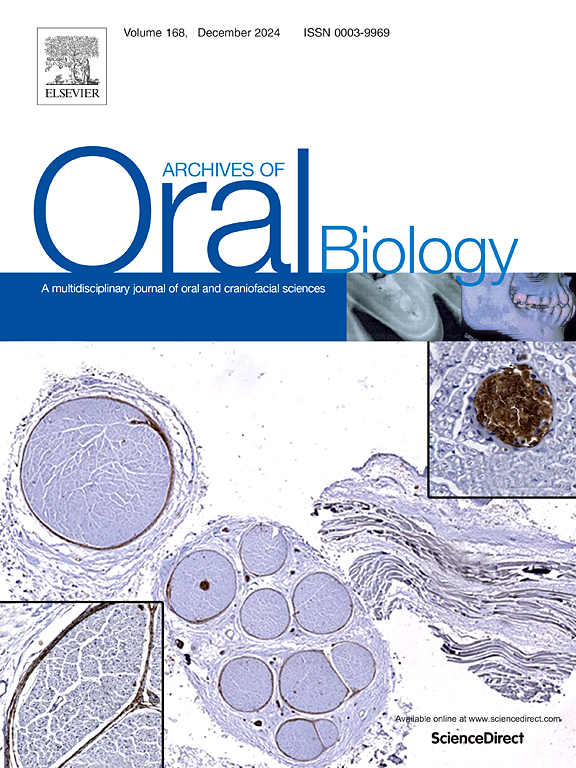通过获得性膜和生物膜微生物组工程,为使用statherin衍生肽(StN15)控制龋齿铺平道路:体外/体内研究的概念验证。
IF 2.1
4区 医学
Q2 DENTISTRY, ORAL SURGERY & MEDICINE
引用次数: 0
摘要
目的:本概念验证性体内/体外研究旨在揭示使用石炭酸肽(StN15)的获得性牙釉质小柱(AEP)工程对AEP蛋白谱、体内牙釉质生物膜微生物群和体外牙釉质脱矿化的作用:体内研究:10 名志愿者在 2 次独立实验(每次 2 天)中用去离子水(阴性对照)或 1.88 × 10-5 M StN15 冲洗(10 mL,1 分钟)。收集 2 小时内形成的 AEP 和 3 小时内形成的生物膜。通过无标记蛋白质组学对 AEP 进行定量分析。使用 16S-rRNA 下一代测序(NGS)对釉质生物膜微生物组进行评估。采用了微宇宙生物膜体外模型。牛牙釉质样本(n = 72)经以下处理:1)磷酸盐缓冲溶液(PBS);2)0.12 % 洗必泰;3)500ppmNaF;4)1.88 × 10-5MStN15;5)3.76 × 10-5MStN15;6)7.52 × 10-5MStN15。生物膜中添加人类唾液和麦克贝恩唾液并培养 5 天。对生物膜进行了抗菌素、菌落形成单位(CFU)和横向显微放射分析(TMR):蛋白质组学结果显示,StN15 组中有几种蛋白质具有抗酸、钙结合和抗菌特性。微生物组证实了这些发现,与 PBS 相比,StN15 组中与龋齿密切相关的细菌减少了。微宇宙生物膜显示,与 PBS 相比,最低浓度的 StN15 在减少细菌活性、CFU 和釉质脱矿方面最为有效:StN15能有效改变AEP蛋白质组,抑制最初的细菌定植,从而减轻釉质脱矿。未来的研究应探索 StN15 的临床应用并阐明其保护作用的机制。本文章由计算机程序翻译,如有差异,请以英文原文为准。
Paving the way for the use of Statherin-Derived Peptide (StN15) to control caries through acquired pellicle and biofilm microbiome engineering: Proof-of-concept in vitro/in vivo studies
Objective
This proof-of-concept sequence of in vivo/in vitro studies aimed to unveil the role of acquired enamel pellicle (AEP) engineering with statherin-derived peptide (StN15) on the AEP protein profile, enamel biofilm microbiome in vivo and on enamel demineralization in vitro.
Design
In vivo studies, 10 volunteers, in 2 independent experiments (2 days each), rinsed (10 mL,1 min) with: deionized water (negative control) or 1.88 × 10−5 M StN15. The AEP, formed along 2 h and the biofilm, along 3 h, were collected. AEP was analyzed by quantitative shotgun-label-free proteomics. The enamel biofilm microbiome was evaluated using 16S-rRNA Next Generation Sequencing (NGS). An in vitro model with microcosm biofilm was employed. Bovine enamel samples (n = 72) were treated with 1) Phosphate-Buffer-Solution (PBS), 2) 0.12 %Chlorhexidine, 3) 500ppmNaF; 4) 1.88 × 10−5MStN15; 5) 3.76 × 10−5MStN15 and 6) 7.52 × 10−5MStN15. Biofilm was supplemented with human saliva and McBain saliva and cultivated for 5 days. Resazurin, colony forming units (CFU) and Transversal Microradiography Analysis-(TMR) were performed.
Results
Proteomic results showed several proteins with acid-resistant, calcium-binding, and antimicrobial properties in the StN15 group. The microbiome corroborated these findings, reducing bacteria that are closely related to dental caries in the StN15 group, compared to the PBS. The microcosm biofilm showed that the lowest concentration of StN15 was the most efficient in reducing bacterial activity, CFU and enamel demineralization compared to PBS.
Conclusion
StN15 can effectively alter the AEP proteome to inhibit initial bacterial colonization, thereby mitigating enamel demineralization. Future research should explore clinical applications and elucidate the mechanisms underlying the protective effects of StN15.
求助全文
通过发布文献求助,成功后即可免费获取论文全文。
去求助
来源期刊

Archives of oral biology
医学-牙科与口腔外科
CiteScore
5.10
自引率
3.30%
发文量
177
审稿时长
26 days
期刊介绍:
Archives of Oral Biology is an international journal which aims to publish papers of the highest scientific quality in the oral and craniofacial sciences. The journal is particularly interested in research which advances knowledge in the mechanisms of craniofacial development and disease, including:
Cell and molecular biology
Molecular genetics
Immunology
Pathogenesis
Cellular microbiology
Embryology
Syndromology
Forensic dentistry
 求助内容:
求助内容: 应助结果提醒方式:
应助结果提醒方式:


